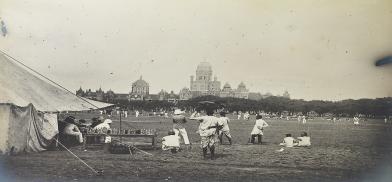Caste, class and cricket: How a colonial sport became a religion in South Asia
The Hindus entered cricket due to their long-standing social and business rivalry with the Parsis. The first Hindu club, the Bombay Union, was formed in 1866. Muslim cricket began with the Luxmani and Tyebjee families, who helped establish a Muslim cricket club in 1883.

The unique affiliation to physical activities in society is crucial for understanding its people and their entertainment, social dynamics, and politics. Cricket, a sport that has gained huge popularity in India, was brought by the British as an escape from culture shocks in an alien land, and later became an instrument for natives to contest their colonial masters. Cricket's history is filled with complex controversies regarding politics, race, and caste. It is an entertaining escape from daily life, teaching teamwork, competition, and politics. Understanding the evolution of cricket from an exclusive pastime to an inclusive sport is vital for understanding its impact on Indian society and its role as an "Indian religion."
Prior to the arrival of the British in India, sports in the region were influenced by mythical accounts of epics, such as the Mahabharata and the Ramayana. These accounts provide insight into the importance of archery, hunting, and wrestling, which were intertwined with military prowess and battlefield utility. Wrestling, a sport with historical relevance, has been played in India since the 13th century.
Racially exclusive clubs
The British did not intend to teach natives cricket, but rather to insulate themselves from the travails of the land through sports, games, and exclusive clubs. Cricket clubs were established in 1792, with matches taking place between teams of the Calcutta Cricket Club, Dum Dum, and Barrackpore. These clubs were considered the "real seat of British power" and were racially exclusive until August 1947. The British colonizers used cricket as a means to ‘escape’ from 'native' India, as it was considered too sophisticated for simple Indians to play and understand.
Sports empowered the British with a cultural superiority over the natives of their colonies, but their dominance was only possible with the acceptance of the Indian elite. The success of this cultural power rested on the ability of the imperial system to have its main social tenets accepted as appropriate forms of behavior and order by the bulk of the client population.
The relationship between the domain of the colonizer and that of the colonized could be observed through interactions, tensions, conflicts, and their own exclusivity. Cricket served as an instrument for the colonial masters to demonstrate British behavior, standards, and moral codes to the local population. However, in the 19th century, the local elite gradually took to the "gentleman's game", challenging the hegemony of British cricket on Indian soil.
Clash of communities
The Parsis of Bombay were the first Indians to play cricket, imitating British ways of playing the sport. In the 1830s, they formed the Oriental Cricket Club, which was replaced by The Young Zoroastrians in 1850. During the 1850s and 1860s, about 30 Parsi clubs emerged, driven by an urge to establish stronger ties with the British.
The Hindus entered cricket due to their long-standing social and business rivalry with the Parsis. The first Hindu club, the Bombay Union, was formed in 1866. Muslim cricket began with the Luxmani and Tyebjee families, who helped establish a Muslim cricket club in 1883. The British unhappiness with the increasing competition from the locals led to the establishment of the all-white Bombay Gymkhana in 1875. Under Lord Harris, Parsi, Hindu, and Muslim Gymkhanas were also formed.
In the later phases of the British Raj, playing cricket became a more serious nationalistic affair, and an arena to challenge and subvert the mighty British Empire. The Hindus began playing against Europeans during the 1880s, and the Triangular Tournament took place in 1907. In 1912, Muslims joined the contest, and the tournament became the Bombay Quadrangular in 1937.
The Quadrangular led to a serious debate on whether community-based cricket could exist within the new Indian nation without the risk of hurting its national integrity. The situation took a serious turn during the 1930s, with Berry Sarbadhikary arguing that community-based cricket was not necessary in India at the time. In 1937, the Bombay Quadrangular Committee considered including a team of the 'Rest' in the tournament, but J.C. Maitra condemned the existence of such a tournament based on caste, creed, color, or class.
It was due to the popularity of the Gandhian mass movements that several communities realized they were not represented enough and it was in 1937 that the tournament became the Pentangular, with the team named “The Rest”, representing the “cultural mosaic of the subcontinent”. Despite the cancellation of the 1939-40 England tour and the 1940 India tour of England due to World War II, domestic tournaments continued. The Pentangular Tournament was still the subject of great debate, with Wazir Ali, the captain of the Muslim team, arguing that it should continue in the interests of Indian cricket. K.S. Duldeep Sinhji argued that inter-community cricket was an unfavorable influence on the whole and urged everyone to support the inter-state Ranji Trophy. Despite the debates, the majority of the Indian public supported the Pentangular Tournament, despite the ongoing communal tensions in India.
Caste and cricket
Palwankar Baloo, the first Indian cricketer great and the first Dalit figure to rise to such popularity, faced immense struggles to make the team. His talent was first recognized by members of the Poona Gymkhana, where he worked as a servant, and the Deccan Gymkhana, the rivals of the Poona Gymkhana, who first noticed his skills. However, Baloo did not enjoy much social respect from his teammates off the field, highlighting the ugly face of casteism that corrupted the spirit of cricket.
Baloo and his younger brothers, Shivram, Vithal, and Ganpat, were quickly recognized for their talents. In 1906, Baloo and Shivram played an integral part in achieving Hindu victory over the Europeans. Historian Ramachandra Guha cites in the Indian Social Reformer as this victory heralded something of a breaking away from the shackles of age-old prejudices so that India could “cease to be the laughing stock of the whole world.”
In the 1920s, several campaigns against untouchability and Mahatma Gandhi's Non-Cooperation Movement gained ground. It was now imperative to make one of the Palwankars captain of the Hindu team for moral and political reasons. Vithal and Shivram withdrew from the team upon Baloo's dismissal, and most Hindu fans supported and found legitimate ground for the acts of protests led by the younger Palwankar brothers.
In 1923, Vithal Palwankar became the captain of the Hindu team, and under his leadership the Hindus won the Quadrangular Tournament for the first time. The vice of untouchability was erased from the minds of the cricketing public, even as the campaign of Gandhi against untouchability was gaining ground.
The Palwankar brothers became legends of Indian cricket despite several atrocities carried out against them. They used their talents to become inspirational figures to empower the depressed castes with voices to demand their own self-respect. Baloo was an inspiration to the Dalits and a subject of admiration to Dr. B. R. Ambedkar, the leader of the "untouchable community". The Palwankar brothers emerged as the new icons of Indian cricket.
Cricket's legacy as a "religion”, in India and South Asia, is evident in its intense fanbase and devotion to the sport. Cricket played a significant role in colonial India, addressing socio-political factors like communalism and casteism, fostering a more inclusive and diverse society.
(The author is a student, Department of History, Jadavpur University, Kolkata. Views are personal)














Post a Comment